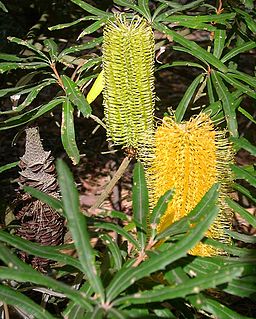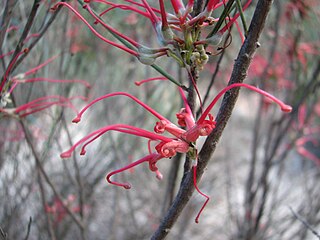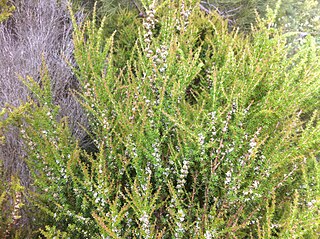
Agonis is a genus in the plant family Myrtaceae. All are endemic to Western Australia, growing near the coast in the south west.

Agonis flexuosa is a species of tree that grows in the south west of Western Australia. It is easily the most common of the Agonis species, and is one of the most recognisable trees of Western Australia, being commonly grown in parks and on road verges in Perth.

Banksia marginata, commonly known as the silver banksia, is a species of tree or woody shrub in the plant genus Banksia found throughout much of southeastern Australia. It ranges from the Eyre Peninsula in South Australia to north of Armidale, New South Wales, and across Tasmania and the islands of Bass Strait. It grows in various habitats, including Eucalyptus forest, scrub, heathland and moorland. Banksia marginata varies widely in habit, ranging from a 20-centimetre (7.9 in) shrub to a 12-metre (40 ft) tree. The narrow leaves are linear and the yellow inflorescences occur from late summer to early winter. The flower spikes fade to brown and then grey and develop woody follicles bearing the winged seeds. Originally described by Antonio José Cavanilles in 1800, further collections of B. marginata were designated as several separate species by Robert Brown in 1810. However, all were reclassified as a single species by George Bentham in 1870. No distinct subspecies have been recognised by Banksia expert Alex George, who nonetheless concedes that further work is needed.

Banksia seminuda, commonly known as the river banksia, is a tree in the plant genus Banksia. It is found in south west Western Australia from Dwellingup (32°42′ S) to the Broke Inlet east of Denmark (34°57′ S). It is often mistaken for, and was originally considered a subspecies of, the Banksia littoralis. Stephen Hopper described the subspecies remanens as a short-leaved shrubby form found in the coastal sands below granite outcrops in the Walpole-Nornalup National Park, however George does not feel this form warrants taxonomic recognition as it lies within the normal variability of the species and there was no clear distinction between it and the other populations of B. seminuda.

Taxandria juniperina commonly known as wattie, native cedar, Warren River cedar or juniper myrtle is a species of tree that grows in the south west corner of Western Australia. This plant was previously classified as Agonis juniperina but is now part of the genus Taxandria. The Noongar peoples know the tree as watti.

Taxandria is a group of plants in the family Myrtaceae described as a genus in 2007. The entire genus is endemic to Western Australia, growing near the coast in the South West corner of the State.

Grevillea sarissa, the wheel grevillea, is a shrub which is native to South Australia and Western Australia. It grows to between 0.6 and 3.5 metres in height and produces yellow, red or pink flowers between August and December in its native range.

Paragonis grandiflora is a plant species, endemic to the Southwest of Western Australia.
Persoonia leucopogon is a species of flowering plant in the family Proteaceae and is endemic to Western Australia. It is an erect to low-lying shrub with branchlets that are densely hairy when young, narrow oblong to narrow elliptic leaves and yellow or greenish yellow flowers borne singly or in groups of up to four on a rachis up to 2 mm (0.079 in) long.

Hakea marginata is a shrub in the family, Proteaceae and is endemic to an area in the Mid West, Wheatbelt, Peel, South West, Great Southern and Goldfields-Esperance regions of Western Australia.
Grevillea rara, also known as the rare grevillea, is a shrub of the genus Grevillea native to a small area in the South West region of Western Australia.
Agonis baxteri is a shrub that is native to Western Australia.
Taxandria angustifolia is a species of tree that grows on the south coast of Western Australia. This plant was previously classified as Agonis angustifolia but is now part of the Taxandria genus.

Taxandria parviceps, commonly known as tea tree, is a shrub species that grows on the south west coast of Western Australia. This plant was previously classified as Agonis parviceps but is now part of the Taxandria genus.

Taxandria spathulata is a shrub species that grows along the southern coast of Western Australia. This plant was previously classified as Agonis spathulata but is now part of the Taxandria genus.

Taxandria linearifolia, also known as the swamp peppermint or the coarse teatree, is a small tree or shrub species that grows along south west coastal areas of Western Australia. This plant was previously classified as Agonis linearifolia but is now part of the Taxandria genus.
Taxandria floribunda is a small tree or shrub species that is endemic to an area in southern Western Australia. This plant was previously classified as Agonis floribunda but is now part of the Taxandria genus.
Taxandria callistachys is a shrub species that is endemic to an area in southern Western Australia.
Taxandria fragrans is a shrub species that is endemic to an area in south western Western Australia.

Taxandria inundata is a species of shrub in the Myrtaceae family that is endemic to an area along the south western coast of Western Australia.












